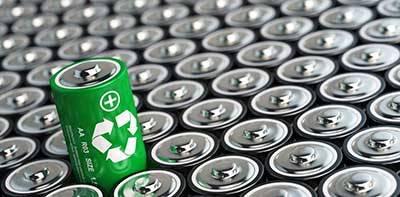Relevance: GS-3: Science and Technology- developments and their applications and effects in everyday life.
Key Phrases: Production Linked Incentive (PLI) scheme, advanced cell chemistry batteries, High-Value Emerging Sectors, Renewable Energy and Electric Mobility, Supply Chain and Energy Security, Upstream Supply Chain, EPR framework.
Why in News?
- The Indian government has recently announced four recipients for its Production Linked Incentive (PLI) scheme for advanced cell chemistry batteries, which aims to establish 50-gigawatt hours (GWh) of domestic cell manufacturing capacity by 2030.
- This is intended to enable the quick growth of high-value emerging sectors such as renewable energy and electric mobility, which are driving battery demand.
Key Highlights:
- India’s annual demand is projected to grow to a level between 105 GWh and 260 GWh by 2030. The establishment of a domestic manufacturing capacity is thus, essential for ensuring supply chain and energy security.
- However, scarce materials that are used in lithium-ion battery chemistries, such as cobalt, nickel and graphite, pose a significant risk for India, which has extremely limited domestic reserves of these materials.
- The industry’s upstream supply chain is largely dominated by China, and markets are too volatile.
- Hence, a robust reuse-and-recycling programme for batteries will enable India to reduce raw material risk and help the country establish sunrise industries that are climate-friendly.
Global Efforts to Increase Recycling Capacity:
- Several international actors are taking steps to build necessary recycling capacity as a response to growing battery demand.
- In China, a number of policies were introduced in 2018 which are aimed at the growth of recycling centres in proximity to electric vehicle (EV) manufacturing hubs.
- The EU has begun the process of establishing policies requiring collection targets, coupled with minimum local content requirements.
- In the US, the country’s department of energy has awarded grants to innovative recycling companies.
Draft Rules on Battery Waste Management by India:
- In February 2020, the ministry of environment, forestry and climate
change (MoEFCC) introduced draft rules on battery-waste management which
have the following provisions:
- Extended Producer Responsibility Programme: These rules aim to establish an extended producer responsibility (EPR) programme.
- EPR framework: Stakeholders in the domestic battery industry (including manufacturers, producers and importers) would be responsible for establishing a collection plan to be approved by regulators.
- Collection of End of Life batteries: The plan must enable the collection of 30% of end-of-life batteries by weight two years after implementation, and gradually escalate this to 70% by the seventh year.
- Recovery of Minerals: Under this policy, materials recovered from recycled EV lithium batteries can provide 5% of our domestic manufacturing needs for minerals such as lithium, nickel, cobalt, and graphite by 2030.
- Effective Market Development Policies: If EV sales accelerate on account of effective market development policies, recovered materials may exceed 20% of domestic lithium battery manufacturing demands for certain materials. The quantity of recoverable material will only increase with time as the volume of EV batteries due for retirement increases.
Need of Recycling Lithium-ion Batteries:
- Utilization of recovered minerals to meet lithium battery demand within India would reduce greenhouse gas emissions by avoiding upstream emissions associated with extraction, processing and transportation.
- It has been estimated that the implementation of the draft rules could reduce 50,000 to 180,000 tonnes of emissions by 2030. Further, as the Indian power grid gets decarbonized, the lithium battery manufacturing process will also become less carbon-intensive.
- Battery recycling would therefore reduce risks to the domestic battery-making industry while complementing the national emission reduction targets announced by India at the CoP-26 summit held in Glasgow last November.
What More Needs to Be Done?
- Boosting the market for Second-life Batteries:
- Currently, only a battery collection target has been set up but policy can be used to bolster the market for second-life batteries.
- A lithium battery used in an EV typically reaches its end of useful life when its usable capacity reaches 70-80% of its nameplate capacity.
- Once the diminished capacity of such a lithium battery pack renders it no longer optimal for EV usage, it can be repurposed for various secondary applications.
- Setting Up Reuse Targets:
- The MoEFCC can establish modest reuse targets for, four-wheel passenger and commercial vehicles and e-buses, which could provide a storage capacity between 1.2 GWh and 5.9 GWh by 2030.
- Guidance for Handling and Storage of Hazardous Material:
- The draft rules should include specific language on hazardous material transport and handling guidance for lithium batteries, formalize second-life performance standards and warranties.
- Robust Mechanism for Remediation and Penalties:
- We need to establish a transparent methodology for identifying issues and stages for remediation and penalties.
- Incentivising Consumer Adoption of EV Vehicles:
- The plans of battery industry stakeholders must take into consideration how costs will impact EV market parity vis-à-vis conventional vehicles, and what mechanisms are used to incentivise consumer adoption.
Conclusion:
- India is on a journey to become a key global player in the battery market.
- The implementation of a reuse-and-recycling programme would not only enhance the resource security of the country’s vehicle electrification and energy transition ambitions, but could also deliver economic development and job growth, while ensuring improved public health and environmental safety.
- Enabling this virtuous circular economy is the need of the hour as India moves towards a sustainable future.
Source: Live Mint
Mains Question:
Q. Discuss the initiatives taken by the Indian government to speed up the waste management of lithium-ion batteries. Also, suggest measures to further increase its recycling capacity. (250 words).







